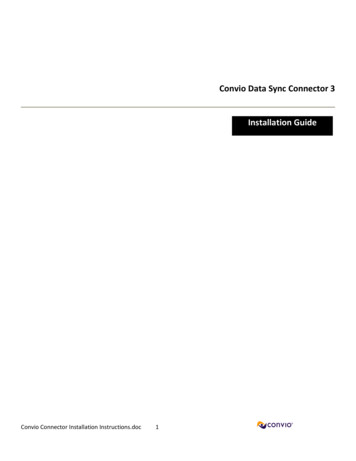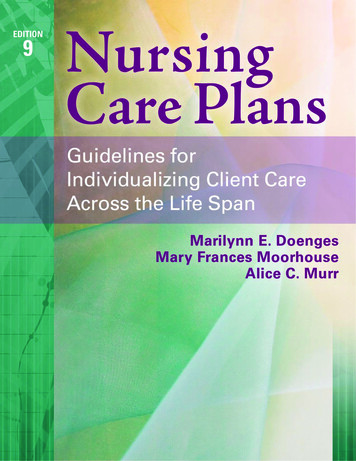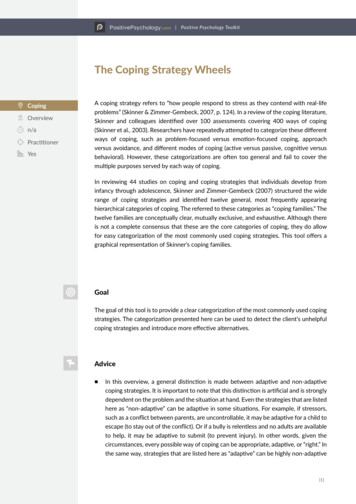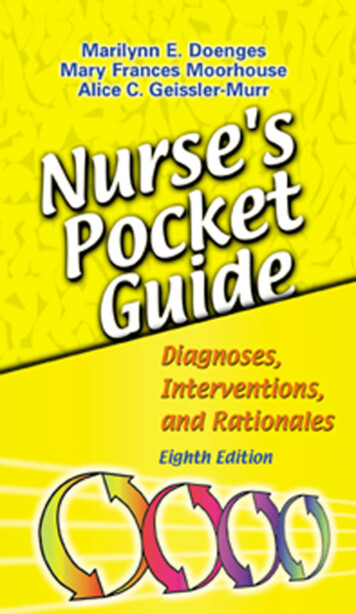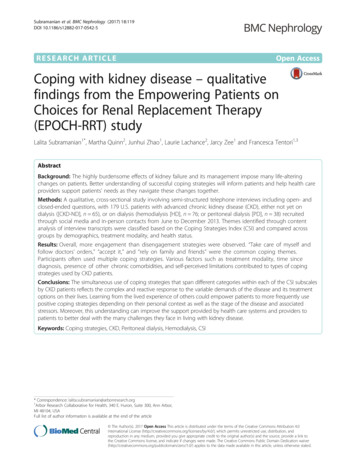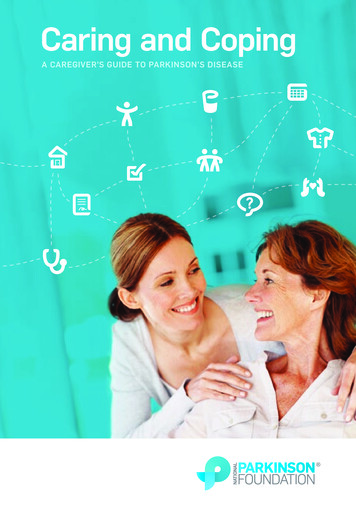
Transcription
Caring and CopingA CAREGIVER’S GUIDE TO PARKINSON’S DISEASE
A PERSONALIZED GUIDE FOR:PERSON WITH PARKINSON’S NAME:PRIMARY CAREGIVER NAME:
Welcome to Caring and Coping,the complete guide for managingParkinson’s Disease. This workbookis for those who care for and aboutpeople living with Parkinson’s disease.Parkinson’s impacts each personin a different way, so there is noone-size-fits-all approachto caregiving. Yourjourney is unique.1
2IntroductionWhether the Parkinson’s diagnosis is new to yourloved one or you have been living with Parkinson’sfor a long time, you have the right and responsibilityto make the care partnership most productive withthe least amount of stress and conflict. Preparationis key in all respects: emotional, financial and physical.We hope that the tips and tools in this workbook willhelp prepare you for every step of the journey.What is caregiving?A precise definition remains elusive, despite growing numbers of people servingin the role of family caregiver. It is estimated that there are almost 45 millionfamily caregivers in the United States, and more than three quarters of them carefor someone over 50 years old.A 2014 report from the National Alliance for Caregiving suggests the followingdefinition: “Caregiving is everything we do to assist a friend or relative due tothat person’s illness or disability, and that we do for our own health.” This bookis focused on that dual role: you provide care for someone else – the “Caring”part of Caring and Coping. Just as importantly, you also must take care ofyourself – the “Coping” portion of this book’s title.
Within this workbook, you will find the following:Tip sheetsWorksheetsThese offer practicalpointers for managingthe complex issues thatarise when you care forsomeone with Parkinson’s.These help you keep importantinformation organized andeasily located. Make copiesor download more fromcaremap.parkinson.org/worksheets,so you can update them asinformation changes.The tip sheets can be foundthroughout this book withorange page borders.The worksheets can be found throughoutthis book with gray page borders.CareMAP videosCaregiver storiesVisit caremap.parkinson.orgto watch videos with more tipsand advice from caregivers andcare professionals to make yourlife easier.You are not alone!Learn from and take comfortin the experiences of otherpeople who care for someonewith Parkinson’s.
Contents4Introduction .2Resources . 6My Contacts WORKSHEET . 8Early in the Journey: Your Caregiver Identity.Caregiver Identity .How to Talk with Your Family About Parkinson’s TIP SHEET .The 7 Needs of Caregivers .Balancing Work and Caregiving .Caring for the Caregiver .Caring for You TIP SHEET .Finding Meaning in Caregiving .Managing Caregiver Stress TIP SHEET .Caregiver Self-Assessment WORKSHEET .Practical Pointers .Organizing Medical Information .Communicating with the Health Care Team .Preparing for a Medical Appointment TIP SHEET .General Health .The Importance of Exercise and Activity for People with Parkinson’s TIP SHEET .Cueing Strategies .Addressing Your Loved One’s Communication Challenges TIP SHEET .Coping with Your Loved One’s Fatigue TIP SHEET .Making Daily Life Easier TIP SHEET .Safety Considerations .Medical Appointment WORKSHEET .Medications & Schedule WORKSHEET .Parkinson’s Symptoms Diary WORKSHEET .Caring from Afar 3Secondary Caregiving TIP SHEET . 76What Not to Do TIP SHEET . 78Primary Caregiving from Afar TIP SHEET . 80
5Getting Outside Help .83When Is It Time to Get Help? . 86Where to Find Help . 88Action Plan for Hiring In-Home Caregivers TIP SHEET . 90Deciding to Hire through an Agency or Privately . 92Preparing Paid Caregivers TIP SHEET . 94Respite Care . 98Rehabilitation and Parkinson’s Disease . 102Daily Routine WORKSHEET . 104Adding Family, Friends and Volunteers to Your Caregiving WORKSHEET . 106Orienting a New Home Care Worker WORKSHEET . 108Questions to Ask a Potential Paid Individual Caregiver WORKSHEET . 110Questions to Ask a Potential Paid Agency Caregiver WORKSHEET . 112Planning Ahead .Be Prepared .Maintaining Important Information .Advance Care Planning .Is a Care Facility Needed? .Advanced PD .What Is Advanced Parkinson’s? .Plans and Scheduling TIP SHEET .Movement Challenges TIP SHEET .Getting Up from a Fall TIP SHEET .Dressing TIP SHEET .Mealtime and Swallowing TIP SHEET .Bathroom TIP SHEET .Thinking Changes and Dementia TIP SHEET .Medications On Time, Every Time TIP SHEET .Skin Protection and Managing Pain TIP SHEET .Activities at Home TIP SHEET .Travel and Transportation TIP SHEET .Rest and Sleep TIP SHEET .End-of-Life Planning .Palliative and Hospice Care .When Caregiving Ends 59161166169172174
Resources6Contact the NPF HelplineYour first call can always be to the NPF Helpline: 800-4PD-INFO (473-4636).Trained Parkinson’s disease information specialists will give you up-to-dateinformation about Parkinson’s, referrals to health care professionals, a widevariety of free publications, emotional support, community resources and more.You can also email us at helpline@parkinson.org at any time.Aging ResourcesThese organizations offer information about services for all older adults.Aging Life Care Association 520-881-8008, www.caremanager.org National Association of Area Agencies on Aging 202-872-0888, www.n4a.org Alliance for Aging 800-96-ELDER (963-5337), www.allianceforaging.orgAARP 888-OUR-AARP (687-2277), www.aarp.orgNext Avenue www.nextavenue.orgRead the special report, Transforming Life as We -life-ageCaregiver AssociationsThese groups provide a range of options for caregiver education, supportand networking.Family Caregiver Alliance 800-445-8106, www.caregiver.orgNational Alliance for Caregiving 301-718-8444, www.caregiving.orgCaregiver Action Network 202-454-3970, www.caregiveraction.orgMedication AssistanceThere are general medication assistance programs as well asprograms specifically for low-income individuals and families.NeedyMeds 800-503-6897, www.needymeds.orgPartnership for Prescription Assistance www.pparx.orgSome pharmaceutical companies provide medication to people who cannotafford it. RxAssist (www.rxassist.org) offers a database of these patientassistance programs.Patient Access Network Foundation Parkinson’s Disease Assistance Program866-316-PANF (7263), www.panfoundation.org/parkinsons-disease
7U.S. Government AgenciesThere are various government programs you and your loved one might be eligiblefor. Call or visit their sites for information and to find out whether you qualify.Centers for Medicare and Medicaid Services800-MEDICARE (800-633-4227), www.medicare.govSearch or ask for the State Pharmaceutical Assistance Programs,the Medicare Savings Programs and the free publication Medicare & You.Social Security Administration 800-772-1213, www.ssa.govSearch or ask for the Supplemental Security Income Benefits.Eldercare Locator 800-677-1116, www.eldercare.govDepartment of Veterans Affairs 800-827-1000, www.va.govNational Institute on Aging 800-222-2225, www.nia.nih.govActivities of Daily LivingThere are many products that can help with activities of daily living.Below are just a few of the many companies that offer such products.Independent Living Aids, LLC800-537-2118, www.independentliving.comIn-Step Mobility Products, Inc. 800-558-7837, www.ustep.comMagnaReady 866-635-8866 www.magnaready.comNational Seating and Mobility 615-595-1115, www.nsm-seating.comReliable Medical Supply, Inc. 763-255-3800, www.reliamed.comSpecially for You, Inc. Specialty Clothing 605-765-9396, speciallyforyou.netAdvance DirectivesThere are several groups that can help you document your medical wishesand preferences.American Bar Association 800-285-2221, www.americanbar.orgSearch or ask for the Toolkit for Advance Planning.Aging with Dignity, Five Wishes www.agingwithdignity.orgNational Hospice and Palliative Care Organization, Caring Connections800-658-8898, www.caringinfo.orgNational Physician Orders for Life-Sustaining Treatment (POLST)Organization 503-494-4463, www.polst.org
WORKSHEETMy Contacts8Medical contactsPRIMARY CARE NAME:PHONE #:ADDRESS:OTHER INFO:NEUROLOGIST NAME:PHONE #:ADDRESS:OTHER INFO:DENTIST NAME:PHONE #:ADDRESS:OTHER INFO:EYE DOCTOR NAME:PHONE #:ADDRESS:OTHER INFO:PREFERRED HOSPITAL NAME:PHONE #:ADDRESS:OTHER INFO:PHARMACY NAME:PHONE #:ADDRESS:OTHER INFO:OTHER NAME:PHONE #:ADDRESS:OTHER INFO:OTHER NAME:PHONE #:ADDRESS:OTHER INFO:OTHER NAME:PHONE #:ADDRESS:OTHER INFO:
9Personal ContactsEMERGENCY CONTACT NAME:PHONE #:ADDRESS:OTHER INFO:FRIEND/FAMILY NAME:PHONE #:ADDRESS:OTHER INFO:FRIEND/FAMILY NAME:PHONE #:ADDRESS:OTHER INFO:NEIGHBOR NAME:PHONE #:ADDRESS:OTHER INFO:CAB/HANDICAP TRANSPORTATION NAME:PHONE #:ADDRESS:OTHER INFO:GROCERY HOME DELIVERY NAME:PHONE #:ADDRESS:OTHER INFO:OTHER NAME:PHONE #:ADDRESS:OTHER INFO:OTHER NAME:PHONE #:ADDRESS:OTHER INFO:OTHER NAME:PHONE #:ADDRESS:OTHER INFO:
10ACKNOWLEDGEMENTSThis book was written and reviewed by expertsin Parkinson’s disease and Parkinson’s care:Joan Gardner, RN, BSNRose Wichmann, PTDiane Breslow, MSW, LCSWPaula Wiener, MSW, LCSWThis book has been made possible through the generous donations of thousands ofindividuals affected by Parkinson’s and grants fromDesign: Ultravirgo
CHAPTER 1Early in the Journey:Your Caregiver Identity11
12Early in the Journey: Your Caregiver Identity.Parkinson’s is a progressive disease: it changesover time. That can make it hard to define your rolein your loved one’s journey, as your involvementand responsibilities will change along the way.This section includes tip sheets related to figuringout how Parkinson’s fits into your life. This includessharing the diagnosis with family, assessing yourwork life and prioritizing your own needs.IN THIS CHAPTERCaregiver Identity . . . . . . . . . . . . . . . . . . . . . . . . . . . . . . . . . . 14How to Talk with Your Family about Parkinson’s . . . . . . . . . . 15The 7 Needs of Caregivers . . . . . . . . . . . . . . . . . . . . . . . . . . 16Balancing Work and Caregiving. . . . . . . . . . . . . . . . . . . . . . 20
13
Caregiver Identity14While your loved one’s Parkinson’s diagnosis probablyOCCUPATIONALPHYSICALchanged your life overnight,caregiver is a role andanTHERAPYTHERAPYidentity that you grow into.Each person with Parkinson’s is unique, and so is each caregiver. As you startthe journey, define “caregiving” for yourself. For some people, caregiver is oneof many roles, or a group they belong to. For others, it is a central characteristic.Many people do not like the term “caregiver.” Especially early in theParkinson’s journey, you might not feel like you are actually “giving” care.Similarly, your loved one might not see himself or herself as someone in need ofcare. But remember, care is not limited to physical tasks. Care can be emotionaland spiritual as well as physical.However you define it, and whatever term you choose—caregiver, care partner,KNOWSENDYOURcarer, etc.—it is important that you acceptthisTHEnew role. It does nothaveUSto eraseFACTSFEEDBACKor replace any existing ways you self-identify; it is an addition, a new facet of youridentity that will help you and your loved one face Parkinson’s disease together.As your loved one progresses through stages of Parkinson’s, you will progressthrough stages of caring. Learn all you can about the disease earlyon, so you can participate in health care discussions, make informed decisionsand provide emotional and physical support now and as needed in the future.And always remember to consider your own needs for wellness, self-careand support.DO THINYOU ENJCH
TIP SHEETHow to Talk with Your FamilyAbout Parkinson’s15Family members — children, siblings andother relatives — want to understand and help.How do you begin to explain Parkinson’s disease to them?First, you must understand the disease yourself. The National ParkinsonFoundation (NPF) offers several options to help you and your family learnall about Parkinson’s disease (PD), including warning signs, diagnosis,symptoms, treatment, living well and much more.»» Explore www.parkinson.org for information on any PD topic.»» Order your free copy of the NPF publication What You and Your Family ShouldKnow. Get it online (www.parkinson.org/books) or by calling the NPF Helplineat 1-800-4PD-INFO (473-4636).»» Download the Parkinson’s Central smartphone app, available for free onboth iPhone and Android devices.Your family may have questions or fears about Parkinson’s and genetics. For thevast majority of people, Parkinson’s is not inherited. There is no test that canaccurately predict who will develop Parkinson’s. Extensive gene and biomarkerresearch is underway to uncover the possible precursors—not necessarilycauses—to disease development.People unfamiliar with Parkinson’s often think of it only as a disorder ofmovement. It is important to help family understand that there are other facetsof the disease, and these can have an even greater impact on quality of life thanthe motor symptoms. Emphasize that Parkinson’s is an ongoing journey, one inwhich we need to face realities little by little, make adaptations, stay connectedto the people and things that are important to us and live each day in the bestway possible.Engage your family to help them understand.»» Include your family in care planning discussions. Ask for their observationsabout how their loved one with Parkinson’s is doing.»» Make specific, concrete requests to your family members about how theycan help you or the person with PD.»» If your family members live out of town, provide them with information aboutParkinson’s and tell them about places they can go to learn more about PD.Refer them to the NPF Helpline for support group referrals or answers toother questions.
The 7 Needs of Caregivers161 Education about Parkinson’s disease Understand the symptoms. Learn about available treatments. Consider the impact of Parkinson’s on everyday life. Access resources. Explore your role in caregiving.2 Time management Make daily and weekly lists of things to do.Make it manageable and realistic. Prioritize: do the most important or difficult things first.Check off what’s done. Save up errands to do more of them at one time. Take a small task with you if you are going some placewhere you have to wait. Delegate what can be delegated. Forget unnecessary tasks. Take a break when pressure gets too great, or as a reward. Don’t do so much in one area that you cannot be effective in another. Break large tasks into smaller, more doable parts. Establish and stick to routines. Recognize that some amount of time will be spent on thingsbeyond your control.
173 Self-care, health andrespiteVISIT ONE OFASK PEOPLEFOR HELP Build in quality time foryourselfOURCENTERS OF(1–1½ hours a day, if possible) and protect it.BEXCELLENCE Keep up with your own needs, hobbies and regular activities. Exercise: it leads to better sleep, decreased tension and depressionand increased energy. Eat a balanced, nutritious diet. Drink water. Recognize when you are stressed. Get enough rest. Take time to relax. Maintain a sense of humor. Get regular check-ups and keep your own medical appointments.PLAN FORREAD STORIES Think about your future.THE FUTUREOF HOPE ANDWhat goals do you hope to achieve, and how can you achieve them?INSPIRATIONCan your loved one help you achieve them?WRITE A TRIBTO A LOVEDLIVING WITH Set limits and stick to them.Bring in outside help (family or paid worker) so that you can take a break.HOW TO CATEGORIZE AND PRIORITIZE NEEDS:Building Your Plan1. I dentify your concerns according to the categories in this section.OCCUPATIONAL2. Place your needsand concerns in priorityPHYSICALorder.THERAPYTHERAPY3. Consider and write down “action steps” that you can take.4. Discuss your ideas with others.5. Devise a step-by-step plan.6. Implement the steps with help from others as needed.DO THINYOU ENJ
THE SEVEN NEEDS OF CAREGIVERS (continued)184 A support team Share the care. Explore ways to get assistance and support as needed.This may include both physical and emotional help. Develop your coping skills. Caregivers experience a wide variety of emotions.Give yourself permission to feel sad or frustrated at times, but also take time toenjoy life. Focus on the present, the needs and rewards of the day. Try not to becritical of yourself in moments of anger. Give yourself credit, not guilt, and tryto forgive any mistakes. Use positive self-talk: for example, tell yourself,“I am doing a good job.” Know that it is okay to grieve the losses that you andyour loved one may experience. Research shows that writing – in a journal orother format – can help you work through your feelings and emotions. Whatcauses you to mourn? Where do you find satisfaction and pleasure? Develop your emotional and spiritual support networks. Include your healthcare team (physician, nurse, social worker, etc.), family, friends, neighbors, supportgroup and individual support group members, clergy, volunteers and onlinesupport forums. Seek comfort from your faith, faith community and spiritualpractices. Find meaning, insight, understanding and your own inner strengths.Adjust your expectations: Life and you are not perfect. Accept changes as theyoccur. Get help if necessary. Remember, it is a strength, not a weakness, to ask forhelp, including emotional help or counseling. Each person experiences depressionin a unique way. It is important to take seriously any symptoms you experiencethat could signal depression; you should not feel embarrassed or ashamed. Be aware of the core symptoms of depression:– Sleeplessness– Feeling slowed down or restless inside– Loss of appetite– No interest in once-pleasurable activities– Difficulty concentrating– Thoughts of death or suicide– Feelings of hopelessness and worthlessnessIf you think you may be depressed, talk to a doctor or mental healthprofessional about your symptoms. Find a supportive professional thatyou trust and with whom you feel comfortable. In most cases, depressionis effectively treated with psychotherapy, antidepressant medications ora combination of both, plus activities such as regular exercise, spirituality,supportive social interactions and meditation.
5 Your relationship with the person with Parkinson’s Maintain open communication. When conversing, remove or turn off loud and distracting noises. Express love and appreciation as well as concerns and feelings offrustration. Don’t let those feelings transform into resentments. Share special time together apart from caregiving tasks.6 Medical, financial and care decisions Define and clarify issues, including family participation in caregiving,advance directives, long-term care options or other topics. Devise steps for carrying out these plans. When making decisions about hands-on care, ask if your decisionpromotes your loved one’s independence: Do not confuse “caring”with “doing.”7 Community resources Take advantage of physical and practical assistance and products. See what resources local associations have to offer. Seek education materials.Many organizations (including NPF) provide these for free. Get legal documents (e.g., power of attorney for health care) in order.(See “Planning Ahead” section starting on page 115 for more information.) Explore resources for financial assistance, e.g., disability. Reach out to a variety of professionals, such as specialist physicians,nurses, therapists, social workers and clergy.19
Balancing Work and Caregiving20Caring for someone with Parkinson’s disease can be a full-timejob, especially as the disease progresses to a more advancedstage. At first, you may be hesitant to tell your employerabout your situation. However, it may be helpful to see if yourworkplace offers any special accommodations for caregivers. Look into your company’s personnel policies. Check your employeehandbook or staff website, or talk to someone from the human resourcesdepartment to learn if your company offers programs or special assistancefor caregivers. If you are a union member, ask a union representative to helpyou negotiate with your employer. Arrange a meeting with your boss, and prepare for it in advance. Before youapproach your boss, decide if you want to discuss your situation as a caregiver,or if you want to go further and request specific job accommodations. Jot downthe most important points you want to address. Be upfront and positive. When you meet with your supervisor, highlight yourstrengths and contributions to the company. Indicate your willingness to worktogether to identify potential accommodations to help you continue to do yourjob while maintaining your role as caregiver. Get it in writing. Send an email to your manager or HR representative withyour understanding of the agreed-upon conditions. This will give everyone areference point.
RGANIZEDURCE,FALLSCLINICALTRIALPOSTUREFOR TEAM HOPE(I.E. VACATION)21Later, if you consider leaving work altogether to accommodatePREPARE FORTALK ABOUT PDBE A COMMUNITYyourDOCTOR’Scaregiving duties,considerthe followingsteps:YOURWITHTHE MEDIAACTIVISTAPPOINTMENTSASK YOUR EMPLOYERTO GETINVOLVED Explore your options. What are your alternatives to resigning? For example,can you take a career break or retire early? Will your employer let you workremotely or part-time? Would you want to consult or freelance on a schedulethat is more suitable to your needs?TAKEPD AWM Take the time you need. The Family Medical Leave Act (FMLA) entitles eligibleemployees of covered employers to take unpaid, job-protected leave forspecified family and medical reasons. During such leave, group health insuranceSET GOALSMAINTAINDOWNLOADOURterms andIMPROVEA GOODRESEARCH YOURcoveragecontinues underthe sameconditions asHIREbeforethe leave.FOR CARE OPTIONSEligible employees are entitled to 12 weeks of leave in a 12-month period inorder to care for a spouse, child or parent with a serious health condition. Understand the repercussions of your options. Ask yourself: Can I managewith less money (and any effect on a pension or retirement plan)? Do not takethis decision lightly. Think about the current and future loss of income if youleave your job. In addition to the possible financial consequences, you shouldconsider the potential loss of independence, social contact and valuable skills.I’m a writer, and I do have to spend a lot of time in my profession working,lecturing and giving workshops, and that’s not easy to do. It is easy if you’vetaken out a long-term insurance policy and somebody comes every day andit’s taken care of, otherwise it can be a very big financial burden. I find thatI just have to take time because it’s our income and it’s our livelihood.Jerry’s very understanding about that.— CAROLYN, CARES FOR HUSBAND, GERALD
22It’s a matter of waking up in the morning and saying,‘I’m glad I’m here, I’m going to make the best of it,and I really am going to enjoy my life.’ Forget aboutParkinson’s; it’s not going to go away. But we can dealwith it, we can handle it and we can find wonderful thingsto do with our lives.— CAROLYN, CARES FOR HUSBAND, GERALD
CHAPTER 2Caring for the Caregiver23
24Caring for the Caregiver. Caregivers havean enormous, often underappreciated job.The job is unique for each caregiver butcarries many common stresses, concerns,fears and rewards. This section is designedto help you, the caregiver, understand andhandle your own particular caregivingsituation, so the role can continue to be –or return to being – a healthy, viable,even rewarding option for you.IN THIS CHAPTERCaring for You . . . . . . . . . . . . . . . . . . . . . . . . 26Finding Meaning in Caregiving . . . . . . . . . . . . 28Managing Caregiver Stress . . . . . . . . . . . . . . 32Caregiver Self-AssessmentWORKSHEET. . . . . . 38
TIP SHEETCaring for You26You may be involved in assisting your loved one with manyactivities of daily living and medical tasks, as well asmaintaining a household; shopping and preparing meals;organizing records, papers and appointments; transportingyour loved one to health care visits; keeping up with socialand family relationships and many other tasks. At the sametime, you may be working, raising children or grandchildrenor coping with your own health or personal issues.Research from the National Alliance for Caregiving shows the top fourcaregiver concerns:1) Keeping your loved one safe2) Managing your own stress3) Finding activities to do with your loved one4) Taking time for yourselfResearch also reveals that when caregivers are asked what they want, themajority res
Activities of Daily Living There are many products that can help with activities of daily living. Below are just a few of the many companies that offer such products. Independent Living Aids, LLC 800-537-2118, www.independentliving.com In-Step Mobility Products, Inc. 800-558-7837,
